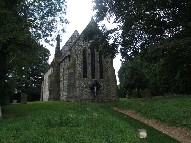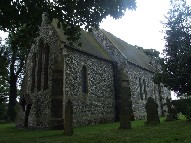
home I index I latest I glossary I introductions I e-mail I about this site
St Margaret, Tatterford
Read
the captions by hovering over the images, and click on them to
see them enlarged.


St
Margaret, Tatterford
As I say, this is a remote, rural parish, and these days it is probably little visited. But Tatterford was once one of the stars in the Anglo-catholic firmament. This was a result of the work of the Parish Priest, Father William Hand, who started a school in Tatterford for boys seeking a vocation to the priesthood. Tatterford church was the focus for their liturgies, and from here the boys went to Mirfield Theological College to train for holy orders. Hundreds of boys from Tatterford went on to become Priests, many of them local north Norfolk boys. Father Hand's son, David, became the Bishop of Papua New Guinea. Because of its proximity to Walsingham, Tatterford was a popular stopping place for Anglo-catholic pilgrims, and on a summer evening there might be hundreds of people here for Benediction. Hard to imagine now. Again because of the Walsingham effect, the goings on at Tatterford were not approved of by the Bishop of Norwich. The school finally closed in the 1940s. This was not deeply regretted by the Diocese, and little remains to show that it was ever here. The crucifix at the top of the path once stood in front of the school, but that's about all. However, enough survives of the Anglo-catholic enthusiasms of those days to send a frisson through anyone coming here to find them. You step into a dark, devotional interior, and all around are statues from the days when this was virtually a shrine in its own right. St George, St Margaret, and something most unusual, an image of the young Christ teaching in the temple, are still on their brackets, and it is easy to imagine ranks of candles flickering in front of them. Father Hand particularly recruited young men who did not have the academic or social background necessary to go to University, and because of this I found the statue of the young Christ very poignant. How it must have spoken to them. |
Simon Knott, October 2007
Amazon commission helps cover the running costs of this site.
home I index I latest I introductions I e-mail I about
this site I glossary
Norwich I ruined churches I desktop backgrounds I round tower churches
links I small
print I www.simonknott.co.uk I www.suffolkchurches.co.uk